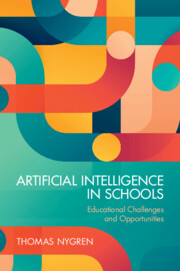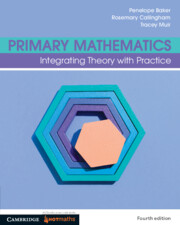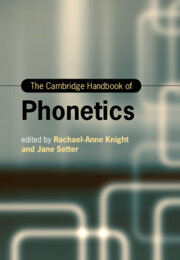Refine search
Actions for selected content:
24 results

Artificial Intelligence in Schools
- Educational Challenges and Opportunities
-
- Published online:
- 24 December 2025
- Print publication:
- 30 October 2025
2 - Sociocultural and Educational Aspects of Irish Language Acquisition
- from Part I - The Socio-educational Context
-
-
- Book:
- The Acquisition of Celtic Languages
- Published online:
- 03 July 2025
- Print publication:
- 10 July 2025, pp 29-46
-
- Chapter
- Export citation
Making use of AI in the Classics classroom
-
- Journal:
- Journal of Classics Teaching / Volume 26 / Issue 52 / Autumn 2025
- Published online by Cambridge University Press:
- 16 June 2025, pp. 142-150
-
- Article
-
- You have access
- Open access
- HTML
- Export citation
‘Exhibit Asia’ and its Deconstruction through Collaborative Online Learning
- Part of
-
- Journal:
- Transactions of the Royal Historical Society / Volume 3 / December 2025
- Published online by Cambridge University Press:
- 04 March 2025, pp. 343-362
- Print publication:
- December 2025
-
- Article
-
- You have access
- Open access
- HTML
- Export citation
Introduction
-
- Book:
- Teaching History in Higher Education
- Published online:
- 07 February 2025
- Print publication:
- 20 February 2025, pp 1-23
-
- Chapter
- Export citation
Promoting Well-being through History Teaching
-
- Journal:
- Transactions of the Royal Historical Society / Volume 2 / December 2024
- Published online by Cambridge University Press:
- 18 September 2024, pp. 471-489
- Print publication:
- December 2024
-
- Article
-
- You have access
- Open access
- HTML
- Export citation

Primary Mathematics
- Integrating Theory with Practice
-
- Published online:
- 01 September 2023
- Print publication:
- 07 September 2023
-
- Textbook
- Export citation
Curriculum considerations in music education in England: spiral thinking, spiral planning and its impact on contemporary thought
-
- Journal:
- British Journal of Music Education / Volume 39 / Issue 1 / March 2022
- Published online by Cambridge University Press:
- 30 March 2022, pp. 131-140
- Print publication:
- March 2022
-
- Article
- Export citation
Chapter 7 - The inquiry process in geography
- from Part 3 - Teaching geography
-
-
- Book:
- Teaching Secondary Geography
- Published online:
- 12 November 2021
- Print publication:
- 13 December 2021, pp 187-200
-
- Chapter
- Export citation

The Cambridge Handbook of Phonetics
-
- Published online:
- 11 November 2021
- Print publication:
- 02 December 2021
Tailoring a training based on the Mental Health Gap Action Programme (mhGAP) Intervention Guide (IG) to Tunisia: process and relevant adaptations
-
- Journal:
- Global Mental Health / Volume 5 / 2018
- Published online by Cambridge University Press:
- 09 May 2018, e17
-
- Article
-
- You have access
- Open access
- HTML
- Export citation
Research capacity strengthening in South Asia: based on the experience of South Asian Hub for Advocacy, Research and Education on Mental Health (SHARE)
-
- Journal:
- Global Mental Health / Volume 4 / 2017
- Published online by Cambridge University Press:
- 16 May 2017, e9
-
- Article
-
- You have access
- Open access
- HTML
- Export citation
Implementing and integrating a radiation oncology information system as a pedagogical tool for undergraduate radiation therapy training
-
- Journal:
- Journal of Radiotherapy in Practice / Volume 16 / Issue 2 / June 2017
- Published online by Cambridge University Press:
- 18 January 2017, pp. 199-206
-
- Article
- Export citation
Developing mental health research in sub-Saharan Africa: capacity building in the AFFIRM project
-
- Journal:
- Global Mental Health / Volume 3 / 2016
- Published online by Cambridge University Press:
- 19 December 2016, e33
-
- Article
-
- You have access
- Open access
- HTML
- Export citation
Review of the clinical benefits and implementation of peer review of treatment plans in undergraduate medical dosimetry and radiation therapy training
-
- Journal:
- Journal of Radiotherapy in Practice / Volume 16 / Issue 1 / March 2017
- Published online by Cambridge University Press:
- 12 December 2016, pp. 85-91
-
- Article
- Export citation
Monitoring and evaluating capacity building activities in low and middle income countries: challenges and opportunities
-
- Journal:
- Global Mental Health / Volume 3 / 2016
- Published online by Cambridge University Press:
- 21 October 2016, e29
-
- Article
-
- You have access
- Open access
- HTML
- Export citation
Global Mental Health: sharing and synthesizing knowledge for sustainable development
-
- Journal:
- Global Mental Health / Volume 3 / 2016
- Published online by Cambridge University Press:
- 19 September 2016, e27
-
- Article
-
- You have access
- Open access
- HTML
- Export citation
Customary Assets and Contemporary Artistry: Multimodal Learning and Remote Economic Participation
-
- Journal:
- The Australian Journal of Indigenous Education / Volume 44 / Issue 2 / December 2015
- Published online by Cambridge University Press:
- 16 September 2015, pp. 184-193
- Print publication:
- December 2015
-
- Article
- Export citation
Transition to practitioner: Redesigning a third year course for undergraduate business students
-
- Journal:
- Journal of Management & Organization / Volume 13 / Issue 1 / March 2007
- Published online by Cambridge University Press:
- 02 February 2015, pp. 65-80
-
- Article
- Export citation
Assembling archaeological pedagogy. A theoretical framework for valuing pedagogy in archaeological interpretation and practice
-
- Journal:
- Archaeological Dialogues / Volume 21 / Issue 2 / December 2014
- Published online by Cambridge University Press:
- 26 November 2014, pp. 197-216
-
- Article
- Export citation
